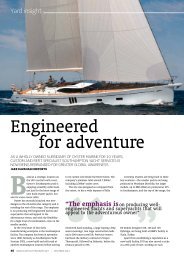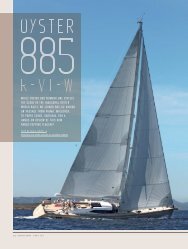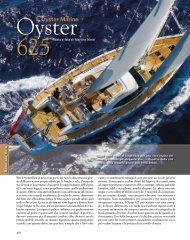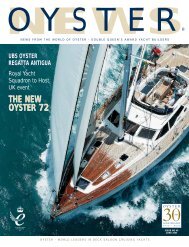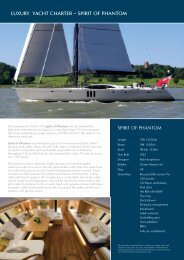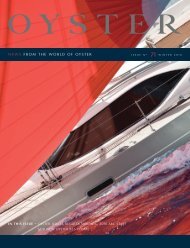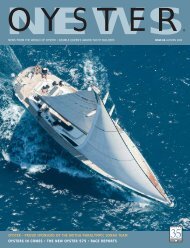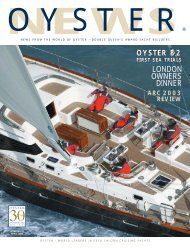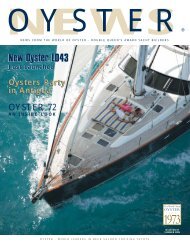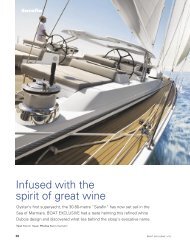You also want an ePaper? Increase the reach of your titles
YUMPU automatically turns print PDFs into web optimized ePapers that Google loves.
FACT BOXTop racing sailors adjust their sailswith every change in condition, bethat a knot of windspeed or analtered sea stateTo lengthen the life of your rollerheadsail always ease halyard tensionafter your passageWhen leaving the boat always ensureyour sail is tightly rolled and the clew issecurely held so the sail can’t unravelRegular inspection of all your sailsmay prevent ongoing damageAnnual washing of your sails toremove salt and dirt will increase thelife of themCarrying a well chosen and fullystocked repair kit onboard willenable you to make necessaryrunning repairs and could saveyou expenseIf in doubt about a repair consult thenearest sailmaker. Repair kits areavailable from <strong>Oyster</strong> After Sales ordirect from Dolphinset correctly. If, however, the top tell-tale lifts first, the car needs adjusting forward.Likewise, if the bottom telltale shows a tendency to lift before the top one, then the carneeds to be adjusted aft.If the boat becomes over-pressed (too much sail for the given wind conditions), beforerolling some headsail away, a good way to maintain balance is to move the car aft a little.This opens the leach and flattens the foot. (See Photos 2 and 3). If an amount of headsailneeds to be furled, the car position should be moved forward to compensate. This willmaintain a good sheeting angle.SHEET TENSIONSheet tension obviously has a major effect on windward ability and performance. Sailing towindward you are looking to achieve the best velocity made good (VMG). Attention to theleach position of the sail, relative to the spreaders via the sheet tension, will pay dividends.In flat water the best VMG is achieved by setting the leach within a few inches of thespreaders. This gives high pointing ability. In rougher waters easing the sheet to allow theleach to clear the spreader by 1-3 feet, whilst reducing pointing ability, will produce betterperformance. Similarly, easing the mainsail traveller down a little in these conditions willhelp your VMG.LEACH AND FOOT LINESThe leach and foot lines in a sail are intended as anti-fluttering controls. If a sail has aflutter, then tension should be applied to either the leach line or the foot line, in order tocalm it. It is necessary to apply only enough tension to stop the movement, so a gentlehand will produce the best result.A small amount of leach 'hook' could occur as a result of tensioning your leach line.This is preferable to a constant fluttering sail. Applying tension tothe leach and foot lines, as necessary, will prevent damage to the sailand prolong its life. Therefore, it is wise to loosen the leach and footline when the tension is not required.BACKSTAYSome boats have easily adjustable backstay tension. Increasing thebackstay tension straightens the forestay and enables the boat topoint higher. Some sag will always occur so don't expect toachieve a straight forestay. Also take care not to over tensionbackstay beyond mast manufacturer/riggers recommended limits.IN THE NEXT OYSTER NEWS WE WILL LOOK ATMAINSAIL TENSIONS/ SETTINGS AND HOW THEYAFFECT BOATSPEED AND HANDLING.RECOMMENDED READINGPhoto 2 Both halyards nicely tensioned, also showsgenoa car slightly back for the bumpy conditions,opening up genoa leach and flattening the foot.Easy Reading: Looking at Sails- Bruce Banks and Dick KennyMedium Reading: The Artand Science of Sailmaking- Tom WhiddenReference Book Level: TheAero/Hydrodynamics of Sailing- Tony Marchjai (pick and choosesections from this book)38 www.oystermarine.com



